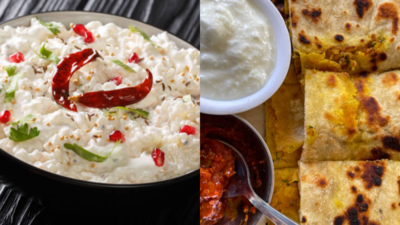- News
- lifestyle
- health-fitness
- diet
- Curd with rice or curd with roti: Which is a healthier option?
Trending
Curd with rice or curd with roti: Which is a healthier option?
Incorporate curd with rice and roti in moderation for optimal nutrition. Choose whole wheat for nutrient density and pair with vegetables for added vitamins.

Curd is an integral part of Indian cuisine. Be it as a flavor enhancer or a side dish, curd somehow finds its way to the dining table in Indian households. This probiotic food helps the gut, has good fat, has lots of nutrients and has different versions.
Have you ever wondered if consuming curd with rice is healthier than having curd with rice or vice versa? Since rice and roti have different micro and macro nutrients composition, it is important to decide which is a good food to have curd with.
Choosing between curd with rice or curd with roti involves considering several nutritional aspects and how they fit into a balanced diet.
Curd with rice
Curd with roti
Roti, the Indian flatbread made from whole wheat flour, offers its own set of nutritional benefits when paired with curd. Roti made from whole wheat flour provides fiber, essential nutrients like B vitamins and minerals such as magnesium and iron. The carbohydrates in whole wheat roti have a lower glycemic index compared to white rice, leading to slower release of glucose into the bloodstream. Curd complements roti by adding additional protein and probiotics for gut health.
Which one would you choose?
The choice between curd with rice or curd with roti ultimately depends on individual health goals, dietary preferences, and overall lifestyle. Here are some considerations to make an informed decision:
Both options provide essential nutrients, but combining whole wheat roti with curd offers a broader range of vitamins, minerals, and fiber compared to white rice.
Incorporating both into a balanced diet
For optimal nutrition, consider incorporating both options into your diet in moderation. Alternate between curd with rice and curd with roti to benefit from different nutrients and flavors. Pay attention to portion sizes to maintain balanced calorie intake and avoid overconsumption of carbohydrates. Opt for brown rice or whole wheat roti whenever possible to maximize fiber intake and nutrient density. Pair curd with a variety of vegetables to add vitamins, minerals, and antioxidants to your meal.
Have you ever wondered if consuming curd with rice is healthier than having curd with rice or vice versa? Since rice and roti have different micro and macro nutrients composition, it is important to decide which is a good food to have curd with.
Choosing between curd with rice or curd with roti involves considering several nutritional aspects and how they fit into a balanced diet.
Curd with rice
Curd, also known as yogurt, is a dairy product rich in protein, calcium, vitamins (like B12 and riboflavin), and probiotics. When paired with rice, which is a staple carbohydrate in many cultures, it provides a balanced meal. Curd contributes protein essential for muscle repair and calcium for bone health. The live cultures in curd support gut health and digestion. Rice provides energy due to its high carbohydrate content, which fuels daily activities
Curd with roti
Roti, the Indian flatbread made from whole wheat flour, offers its own set of nutritional benefits when paired with curd. Roti made from whole wheat flour provides fiber, essential nutrients like B vitamins and minerals such as magnesium and iron. The carbohydrates in whole wheat roti have a lower glycemic index compared to white rice, leading to slower release of glucose into the bloodstream. Curd complements roti by adding additional protein and probiotics for gut health.
Which one would you choose?
The choice between curd with rice or curd with roti ultimately depends on individual health goals, dietary preferences, and overall lifestyle. Here are some considerations to make an informed decision:
Both options provide essential nutrients, but combining whole wheat roti with curd offers a broader range of vitamins, minerals, and fiber compared to white rice.
- If managing blood sugar levels is a concern, whole wheat roti may be a better choice due to its lower glycemic index compared to white rice.
- Consider personal tolerance to gluten and wheat products. Some people find rice easier to digest, while others may prefer the satiety and nutritional benefits of whole wheat roti.
- Choose based on cultural traditions and dietary habits that promote enjoyment and satisfaction with meals.
111099144
For optimal nutrition, consider incorporating both options into your diet in moderation. Alternate between curd with rice and curd with roti to benefit from different nutrients and flavors. Pay attention to portion sizes to maintain balanced calorie intake and avoid overconsumption of carbohydrates. Opt for brown rice or whole wheat roti whenever possible to maximize fiber intake and nutrient density. Pair curd with a variety of vegetables to add vitamins, minerals, and antioxidants to your meal.
End of Article
FOLLOW US ON SOCIAL MEDIA









